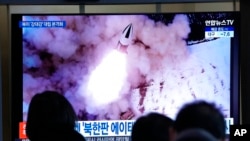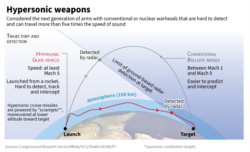Experts say North Korea’s hypersonic missile is hard to track and intercept because of its ability to maneuver, leaving South Korea vulnerable to North Korea’s missile attacks.
According to Jeffrey Lewis, a missile expert at the Middlebury Institute of International Studies at Monterey, the missiles’ capabilities may leave South Korea with little choice but to launch preemptive strikes on North Korea’s leadership before the regime orders the firing of missiles.
Despite the focus of attention on the missile’s speed, the real danger comes from the missile’s ability to maneuver, Lewis said.
He added that what North Korea tested earlier this month were maneuvering reentry vehicles (MaRV). A MaRV is a detachable gliding warhead that can change its course of flight.
“It’s just not right to say that this represents a shorter time of flight,” Lewis said. “What it represents is the ability to maneuver. So, the value of the maneuvering reentry vehicle is not that it would get to its target faster because it will get there slower.”
Hard to intercept
Lewis said the maneuverability of the missiles make them difficult to detect and intercept once they are in flight using missile defense systems.
He also said using preemptive strikes to destroy the missiles or launchers as they are being prepared to take off is equally difficult because locating where North Korea would fire them is hard to assess and target.
“It’s almost impossible to go out and find and destroy the launchers and so the only viable strategy South Korea has ever had has been to target the North Korean leadership before it can give the order.” Lewis said, adding, “That is extremely escalatory and dangerous in a crisis.”
North Korea said it successfully test-fired hypersonic missiles on Jan. 5 and Jan. 11.
“The test launch clearly demonstrated the control and stability of the hypersonic gliding warhead,” said North Korea’s state-run Korean Central News Agency (KCNA) on Jan. 6, referring to the test conducted Jan. 5.
On Jan. 12, KCNA said, “The test-fire was aimed at the final verification of overall technical specifications of the developed hypersonic weapons system,” regarding the test conducted Jan. 11.
Bruce Bechtol, a former intelligence officer at the U.S. Defense Intelligence Agency and now a professor at Angelo University in Texas, said the hypersonic missiles that North Korea tested appear to “have evade abilities better than anything [the regime] tested thus far,” being able to dodge “ballistic missile defense and anti-aircraft fire.”
Bechtol also said the missiles seem to have “more pinpointed accuracy than most of other” North Korean missiles.
Raising stakes
Ankit Panda, a senior fellow for the Nuclear Policy Program at the Carnegie Endowment for International Peace, cautioned against South Korea using preemptive strikes.
“There’s a big risk brewing on the Korean Peninsula in that both Koreas are building large missile arsenals that they anticipate using first in a crisis,” said Panda. “The pressures to preempt are strong on both sides, and this can lead to a war that neither side intends through miscalculation.”
Bruce Bennett, a senior defense analyst at the RAND Corporation research center, said South Korea should consider destroying North Korea’s missiles before they are launched because of the risk associated with relying only on missile defense systems designed to intercept missiles during flight.
“Your missile defenses can’t do the whole job” because “missile defense systems aren’t everywhere in South Korea” leaving too many targets unprotected and because of the brief flight time from North Korea, Bennett said. “You’ve got to have capabilities to destroy these missiles as part of the Kill Chain, essentially.”
The Kill Chain is a part of South Korean strategy to identify and preemptively strike key North Korean missiles and nuclear sites if threats appear imminent.
Return to brinkmanship
According to David Maxwell, a senior fellow at the Foundation for Defense of Democracies, North Korea’s recent missile tests show regime leader Kim Jong Un “is executing a political warfare strategy and developing the capabilities to fight and win a war” that “relies heavily on its blackmail diplomacy – the use of increased tension, threats and provocations to gain political and economic concessions.”
Bennett said Pyongyang’s reference to the missiles it conducted as “hypersonic” should not be taken at face value.
“They’re not what the U.S. or the Russians or the Chinese call a hypersonic missile,” Bennett said. “North Korea tends to exaggerate what it’s got.”
In response to North Korea’s supersonic missile tests, the U.S. imposed unilateral sanctions on the regime’s weapons program on Jan. 12.
On the same day, U.S. Ambassador to the U.N. Linda Thomas-Greenfield called for more international sanctions on North Korea.
Following the U.S. sanctions, North Korea conducted two more tests of what it called tactical guided missiles on Jan. 14 and 17.
U.S. Deputy Secretary of State Wendy Sherman on Tuesday condemned North Korea’s missile tests during her phone conversation with Choi Jong-kun, South Korea’s first vice foreign minister, as the two discussed their efforts to denuclearize the Korean Peninsula.





